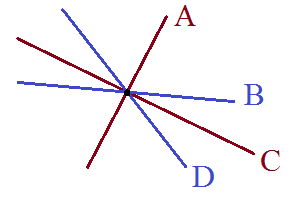The abbreviation TFAE (the following are equivalent) is often used in the statement of various theorems. Of course, a completely synonymous phrase would be ‘any one of these implies the other n − 1′. This then admits a natural generalisation to ‘any k of these together imply the other n − k‘. We shall refer to these situations as (n,k)-TFAE.
It is obviously possible to construct artificial examples for any k, such as the following set of statements:
- a = 0
- b = 0
- …
- c = 0
- a + b + … + c = 0
However, these examples are completely boring, so we’ll just concentrate on more interesting examples instead. The case k = 1 is just regular TFAE, so the next thing to try is k = 2, i.e. ‘any two of these imply the others’. One such example is the new Mersenne conjecture, formulated by Bateman, Selfridge and Wagstaff:
Let p be an odd natural number (only interesting when p is prime). Then, any two of these implies the third:
(a) p = 2k ± 1 or p = 4k ± 3
(b) 2p – 1 is a (Mersenne) prime
(c) (2p + 1)/3 is a (Wagstaff) prime
Of course, this is only conjectural, although heuristically it is expected to be true (with the three properties being simultaneously satisfied only by 3, 5, 7, 13, 17, 19, 31, 61 and 127).
These cases of ‘any two conditions imply the third’, or (3,2)-TFAE, are reasonably common. If P and Q are two finite sets, and f is a function with domain P and codomain Q, then any two of the following statements imply the third:
- f is an injection.
- f is a surjection.
- P and Q are of equal cardinality.
Obviously, the case where all statements are true corresponds to f being a bijection. Equally obviously, this does not hold in general if P and Q are allowed to be infinite.
A more interesting example of (n,2)-TFAE, where there are four statements rather than three, is from Euclidean geometry. Suppose we have a pencil of four distinct lines passing through a common point, as shown above. Then, any two of the following statements together imply the other two:
- Lines A and C are perpendicular.
- A is an angular bisector of BD.
- C is an angular bisector of BD.
- (A, C; B, D) is a harmonic pencil.
I don’t have any other examples of (4,2)-TFAE, or indeed any examples of (n,k)-TFAE with k > 2. Using the ‘comments’ feature below, please post any non-trivial examples of (n,k)-TFAE (k > 1) you can find:


I just like the valuable info you supply for your articles.
I will bookmark your weblog and check again right here
regularly. I’m reasonably certain I will be told plenty of new stuff proper here! Best of luck for the next!
Pingback: Ten things you (possibly) didn’t know about the Petersen graph | Complex Projective 4-Space
A (3,2) example for trees:
1. G is connected
2. G is acyclic
3. m=n-1